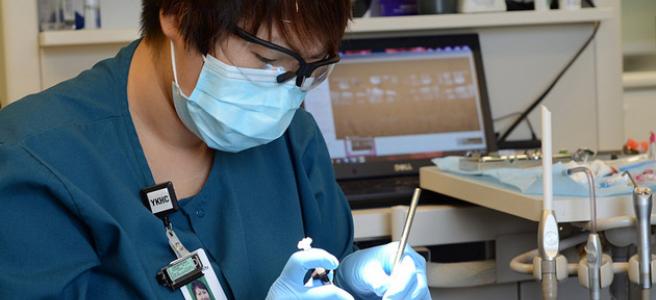
Michael Mello | Special to Equal Voice News
When it comes to health care access, New Mexicans might not think of their state as “The Land of Enchantment” because an estimated 40 percent of the state’s population – at least 834,000 people – live in what the U.S. government calls a primary care health professional shortage area.
Among the professionals in short supply are dentists. The state ranks 49th in the nation in the ratio of dentists to population.
Thirty of the state’s 33 counties have a serious dental care shortage, according to Health Action New Mexico, a nonprofit organization that strives to ensure all New Mexicans have access to health care. Two counties are without a single dentist to serve residents.
Dental Care Access in U.S.
- About 130 million Americans lack dental insurance.
- About 47 million Americans do not have easy access to dental care.
- Yearly, 17 million low-income kids do not have dental care.
- In 2009, 830,000 emergency room visits could have been avoided through regular dental care.
Source: U.S. Senate report from 2013
As the nation focuses on the Affordable Care Act – and the goals of broadening health access and addressing soaring costs – nonprofit groups, officials, doctors and even some dentists are advocating that New Mexico be allowed to try a new type of dental professional.
They support the use of “dental therapists,” who are not dentists but who have the training and skills to provide care beyond a regular hygienist. They are “mid-level” providers with their work roughly analogous to that of nurse practitioners in the medical field.
To earn a dental therapist license, hygienists must complete additional dental schooling, which can last about 18 to 24 months. They can then perform routine but important dental procedures such as filling cavities and extracting teeth.
With patients requiring complex work, dental therapists would stabilize them, preparing them to see a licensed dentist in the near future.
The Debate Over “Dental Therapists”
Proponents in New Mexico are not alone in pushing for the change. The American Dental Hygienists’ Association reports that more than a dozen states are considering or already working on models for dental therapist programs.
The American Dental Association and many state dental groups have opposed the creation of such programs, saying dental work should remain the purview of those with full licenses.
Proponents say thousands of people could be helped by such practitioners.
Dr. Arturo Sisneros, a dentist, knows about the lack of available care in northern New Mexico. It’s difficult for him to keep a full staff in the three nonprofit dental clinics he oversees.
“I know it would help me out,” he said. “We’re always short dentists.”
New Mexico’s rural nature and lower salaries for many jobs, he said, means professionals from more populous parts of the country are reluctant to relocate.
A dental hygienist from New Jersey recently scoffed at the salary Sisneros was willing to pay her if she moved to New Mexico.
“The salaries are lower here,” Sisneros, a Taos native, said. “But the cost of living is lower.”

Christy Jo Fogarty, the first dental therapist hired in Minnesota, helps a patient at Children's Dental Services. The group's executive director said that she is doing well at the clinic. Photo courtesy of Children's Dental Services.
A dental therapist program would help fill the gap, he said, because such work is more likely to use local professionals.
But Sisneros has one reservation.
“The bad side is I can see corporate offices taking advantage of dental therapists,” he said, laying off dentists and relying on less-expensive therapists to maximize profits at the expense of patient care.
“If done in the right way, it will definitely help clinics meet patient needs, especially in rural areas,” Sisneros said.
One View From Central New Mexico
Michael Bird said his community could also use the help of dental therapists. He’s vice chairman of the health board for the Kewa Pueblo — formerly called the Santo Domingo Pueblo — an American Indian tribe in central New Mexico.
Seventy percent of Kewa Pueblo adults between the ages of 20 and 44 have untreated cavities according to a University of Colorado study. The little dental care that is available usually goes to the children.
“Adults are really being impacted in a negative way,” he said.
Despite being located about 30 miles from Albuquerque and Santa Fe, the Kewa Pueblo’s proximity to the state’s biggest cities doesn’t mean that dental care is easier to access.
Not everyone has dental insurance, and many dentists don’t participate in state or federal assistance programs. “If you can’t find a provider to accept Medicaid for care, well, you’re not going to get it,” Bird said.
Neglected teeth and gums often lead to bigger problems. Left untreated, abscesses can become infected and the infection can invade other parts of the body. An inability to chew can affect a person’s diet, which can exacerbate diabetes or other health conditions.
“Many people are having to access care in hospital emergency rooms because they’re in such pain,” Bird said.
Even then, emergency rooms aren’t typically equipped to handle dental care.
“It’s a crisis, not only in the American Indian community, but many rural communities,” said Bird, who supports the use of dental therapists.
Read more: http://www.equalvoiceforfamilies.org/not-a-dentist-is-a-dental-therapist-the-solution/

